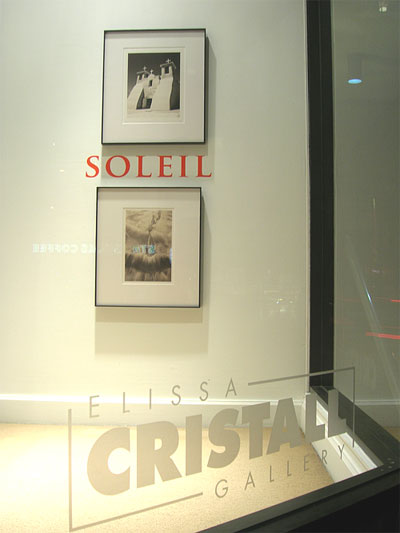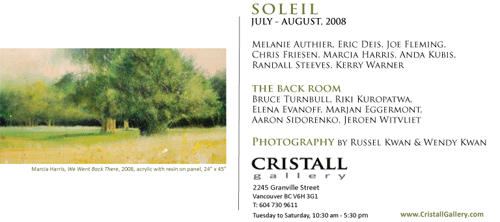Wendy Kwan on SOLEIL at Elissa Cristall Gallery
Ephemerons
Visual discoveries are a key part of my photographic process. I’m always looking and trying to interpret the fascinating things that make up our visual world. “Ephemerons” are my personal response to one such intriguing and extraordinary discovery.
A quiet beach, near Gearhart on the Oregon coast, revealed a phenomenal scene. Through the action of wind, tide, water, and on the heels of an unusually stormy season, a short stretch of beach had been transformed into series of unusual shapes and patterns. Abstract, rhythmic, surreal, any number of translations presented and captivated me. I worked quickly and deliberately, aware that the perfect high overcast light, and the fleeting features themselves, would likely never combine again. This is peak performance time for a photographer, when all acquired visual and technical skills are called upon to create a sensitive interpretation.
“Ephi” and “Ephu”, part of the Ephemerons series, result from my “day at the beach”. As viewer, you are now welcome to explore and interpret the photographs, from your perspective.
Tea Master’s Garden
The simplicity and subtle beauty that permeates Japan and other south-east Asian countries, is expressed in every aspect of the culture. In 2004, I was fortunate to travel and photograph in Japan, Cambodia, and Thailand and experience these qualities first hand.
A very special place I visited was the teahouse and garden of Sen no Rikyu, a 16th C Japanese tea master. In his time, Rikyu was known for returning traditional tea ceremonies, which were increasingly creeping toward elaborate and ostentatious affairs, to a state of modest simplicity. A stone in a garden path at the back of the teahouse became the catalyst for the creation of a series of photographs, which I hope convey the sense of simple classic form and beauty that for me is essence of these lands.
“Tea Master’s Garden”, “Quiet Corner”, and “Special Wishes” are three photographs from the Tea Master’s Garden series.
Apparent Realities
Film based photography and photographic prints produced in a traditional wet chemistry darkroom equals truth in rendering of what was actually seen or perceived. True or false?
Even today, forensic investigators are returning to film as a recording device, for its’ apparent ability to record what was real. How “real” is the traditional photographic process? Aside from techniques that can be employed at the camera stage, (choice of lens, viewing angle, type of film, sharp or soft, multiple exposure, and so many more!!) the wet darkroom also holds many possibilities for manipulating and massaging the “way” a final photographic print can be presented.
Double negative printing represents my opportunity to play with both photographic process and the notion of apparent reality. I have always been fascinated with the idea of image “collage”, but only over the past couple years have started to employ it in my own traditional photographic work. Each negative is exposed independently onto the paper to achieve maximum control in printing and to create the desired effect.
“Fort Casey” and “In The Window” are two of my current apparent reality photographs.
Russel Kwan on SOLEIL at Elissa Cristall Gallery
I have been photographing old things for many years. Old, often broken things. Things that have suffered much, but somehow bear their age and torment with dignity, even defiance. Things that stand to give others a reason to keep going. I’ve been told these pictures speak of hope, but for me, they speak of a certain strength in an uncertain future.
“Humberto Rising” was made on the Texas coast of The Gulf, on the eve of hurricane Humberto’s arrival in September 2007, his eyewall crashing ashore just 20 miles up the beach from this spot. The last rays of sunshine for a few days were warming the old fence, which has clearly seen more than its share of hurricanes, and like a punch-drunk prizefighter, is still standing against the inevitable.
“Genuflection” was made on Easter Sunday morning at the Mission de Rancho de Taos in New Mexico. The day was already impossibly hot, and the church with its fortress walls stood alone, offering its parishioners shelter not only from the heat, but also the world. It is interesting to reflect that insulation from the world is necessary even in such a faraway outpost. That little church is famous enough that it is usually buried in a mass of automobiles, parked right against its giant buttresses. The only reason there were no cars and tourists around at this moment was the Easter service had just ended, and the standing room only crowd had vanished for lunch, leaving the plaza to a peace it now rarely knows.
“Letters from Deyrolle, Paris” is my new (and still in progress, planned to comprise 20 to 30 photographs) series based on a 19th century French botanical collection that came into our hands in the spring of 2007. The lovingly collected, composed and pressed plants, complete with descriptions of their medicinal properties were compiled for one Mme Robert, between 1879 and 1903 by Parisian naturaliste Emile Deyrolle, son of Achille Deyrolle, founder of their namesake business in 1831. It was Emile who moved the shop to 46 Rue de Bac, Paris – an address it still occupies today. In 2001, the fourth generation of Deyrolles sold the business to Prince “Jardinier” Louis-Albert de Broglie, who has continued operations under the Deyrolle name. Tragically, a fire destroyed much of the historic building in February 2008, and efforts to restore it are under way – but the loss of historical artifacts is immeasurable. My homage to Emile represents the confluence of his botanical collection with my own continuing research into the physics and chemistry of traditional silver-based photographic processes – coincidentally discovered in France about the same time Achille set up shop. For some time, I’ve been looking for a way to impart personal gesture and handwork into my photography, while maintaining the characteristics of the silver-gelatin print. In early 2008, I started experimenting with a process I now call Chromakinesis (adopted from Greek: colour = χρώμα and movement = κίνηση) – a chemical and physical means for changing the size and distribution of silver particles in the print, creating unusual patterns and colours. Handpainting the chemistry makes each print unique – while the subject negative may be reproduced, the pattern of colours cannot be. The final photograph has the same chemical and physical makeup of any museum quality silver gelatin print, but my hand is clearly visible. The firelike patterns in these prints is my reaction to the fire at DeyRolle, and the boldly visible, but clearly frail botanical collection represents my hope for their future.

